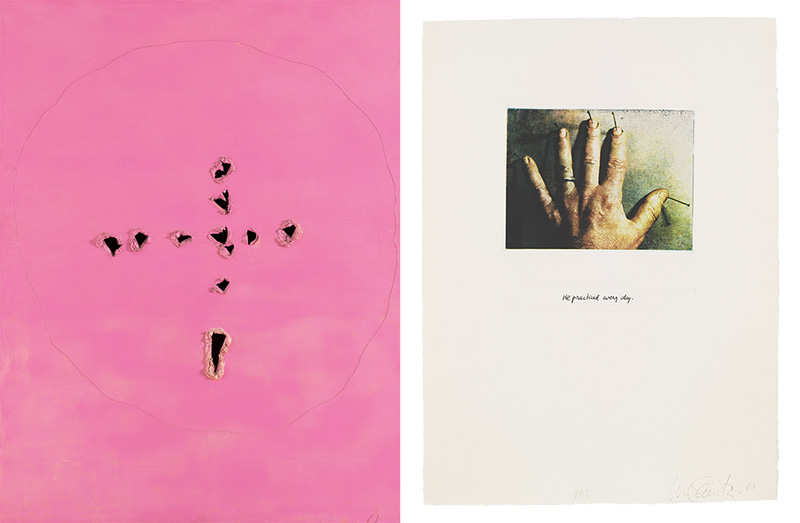ART-PRESENTATION:A Tale of Two Worlds,Part II
The exhibition “A Tale of Two Worlds: Experimental Latin American Art in Dialogue with the MMK Collection 1940s-1980s” sets out to establish a dialogue between two distinct narratives in Western contemporary art over the five decades spanning the 1940s and the 1980s: the European-North American canon as represented in the MMK Collection and Latin American experimental art (Part I).
By Dimitris Lempesis
Photo: Museum für Moderne Kunst Archive
The exhibition “A Tale of Two Worlds: Experimental Latin American Art in Dialogue with the MMK Collection 1940s-1980s” with 500 artworks from Private and Public Collections by 100 artists and collectives from Latin America, the United States and Europe, brings the works of the MMK Collection into a depth dialogue with key works of Latin American art. The exhibition will accommodate some While the MMK collection from the 1960s and 1970s focuses on European and North American art, the period of Latin American art addressed in this exhibition starts in 1944, the year of the first exhibition of the new Concrete Art Movements in Argentina, and continues until the end of the military dictatorships in the late 1980s. Through the example of avant-garde artists from Latin America, the USA and Europe the exhibition attempts to locate the precise tipping point in the transition from Modern to Contemporary art. It foregrounds various forces of change in order to illustrate this moment of transition, when modernist models collapsed. Organized along three main axes and sixteen sub-sections, it deals with the development of the history of art from the various continents of the world both chronologically and conceptually. They include such areas as “The Social Body or “When Pop Becomes Critical’, in which the curators emphasize the ways colonialism, consumerist critiques, political repression and military rule have shaped the socio-political context for a specific artistic praxis to produce an explicitly political form of art. The introductory first axis explores the art of Lucio Fontana as a response to the Concrete Art Movements of the River Plate region in the 1940s and as a mirror to the destructive practices in the Europe and Latin America of the 1950s. The axis also examines the politics involved in cutting through a surface to critically see through it and expose a complex socio-political situation, as in the Neo-Concrete works of 1960s Brazilian artists and the works produced to denounce the various dictatorships in the Southern Cone in the 1970s. The second axis focuses on the shift produced by artists who redirected their attention from the material to the immaterial dimension of art and from the realm of the object towards the realm of the lived experience, as in the practices of Alberto Greco, Yves Klein or Franz Erhard Walter. This axis also presents artists who analyze the experience of the urban environment and its counterpart, the intimate domestic space. It addresses the complexities of an art that touches upon conceptions of Pop Art only to dismantle them and upon conceptions of colonialism to critically condemn the present. The third axis brings the figure of the artist back to the fore as they establish their roles in society and the environment (Joseph Beuys, Nicolás García Uriburu, Ana Mendieta) or obsessively record their actions in time (On Kawara, Arthur Bispo do Rosário, Edgardo Antonio Vigo). This final axis explores diverse strategies of enunciation, in particular writing as a tool to speak out in and about a broader socio-political context. The exhibition ends with a remarkable analogy between the two worlds. Kenneth Kemble’s “Gran pintura negra” (1960) and Roy Lichtenstein’s “Yellow and Green Brushstrokes” (1966) are displayed side by side to signal the complex appropriation of the painting tradition by conceptual strategies in answer to specific movements. While Lichtenstein creates a monumental brushstroke recurring to the language of the comic-strip with its solid colour and its Ben-Day dots, Kemble made use of a grid to rationally amplify and stage the single brushstroke on this canvas.
Info: Curators: Victoria Noorthoorn, Javier Villa and Klaus Görner, MMK 1, Museum für Moderne Kunst Frankfurt am Main, Domstraße 10, Frankfurt am Main, Duration: 25/11/17-2/4/18, Days & Hours: Tue & Thu-Sun 10:00-18:00, Wed 10:00-20:00, mmk-frankfurt.de


![Left: Lenora de Barros, Poema, 1979, © Fabiana and Lenora de Barros, Photo: Axel Schneider, Museum für Moderne Kunst Frankfurt am Main Archive. Right: Ulises Carrión, S. t. [Untitled], not dated, Archivo Lafuente, © Archivo Lafuente, Photo: Axel Schneider, Museum für Moderne Kunst Frankfurt am Main Archive](http://www.dreamideamachine.com/web/wp-content/uploads/2017/12/0410.jpg)








![Lucio Fontana, Concetto spaziale (Space Concept) [Detail], 1962, Courtesy Fondazione Lucio Fontana, © Lucio Fontana by SIAE / VG Bild-Kunst, Bonn 2017, Museum für Moderne Kunst Frankfurt am Main Archive](http://www.dreamideamachine.com/web/wp-content/uploads/2017/12/0014.jpg)